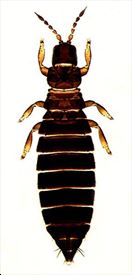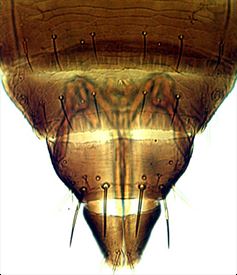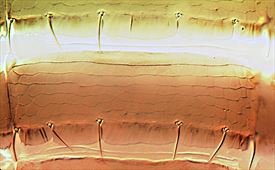Distinguishing features
Both sexes wingless. Body, legs and antennae dark brown. Antennae 8-segmented, VI with partial, oblique suture producing an apparent 9-segmented condition; III–IV each with sense cone simple. Head weakly reticulate, with no ocelli; ocellar setae III as long as diameter of 3 eye facets. Pronotum almost without sculpture medially, with no long setae. Meso and metanota transverse. Prosternal basantra with no setae; ferna continuous medially; meso and metafurca without spinula. Tergites with several lines of sculpture medially; posterior margin of I–VIII with well-developed craspedum; postero-angular setal pair arising in front of margin. Sternites III–VI with well-developed 5-lobed craspedum; VII with median craspedum lobe not developed, median pair of setae arising in front of margin.
Male smaller and paler than female; sternite III antecostal region with transverse pore area opening into a large vesicle within the third abdominal segment; tergite VIII with 2 pairs of stout thorn-like setae.
Related species
The head and pronotum are similar to those found in Anaphothrips species, but the lobed craspeda on the sternites are characteristic. Only two species are recognised in the genus Apterothrips. The second species, A. secticornis, has seven lobes to each sternal craspedum and is probably restricted to the Northern Hemisphere. The New Zealand record of secticornis in Mound & Walker (1982) was a misidentification of apteris (Nakahara, 1988).
Biological data
This species is known to feed and breed on the leaves of several unrelated plants in different parts of the world, including Erigeron (Asteraceae), Medicago sativa (Fabaceae), Allium (Liliaceae), grasses (Poaceae).
Distribution data
This species is widespread throughout New Zealand (ND, AK, CL, WO, BP, TO, HB, WI, WA, WN / NN, SD, MB, KA, BR, MC, SL / Chatham Islands). Presumably native to the West coast of the Americas, it is distributed from southern California along the western coast of South America to the Falkland Islands. It was probably distributed by the whaling industry to New Zealand, Western Australia, Tasmania and Norfolk Island.
Family name
THRIPIDAE, THRIPINAE
Species name
Apterothrips apteris (Daniel)
Original name and synonyms
Sericothrips apteris Daniel, 1904: 295
Sericothrips stanfordii Moulton, 1907: 51
Sericothrips ineptus Ahlberg, 1922: 271
Apterothrips delamarei Bournier, 1962: 231
References
Mound LA & Walker AK (1982) Terebrantia (Insecta: Thysanoptera). Fauna of New Zealand 1: 1–113.
Nakahara S (1988) A new synonym and revised status in Apterothrips (Thysanoptera: Thripidae). Proceedings of the Entomological Society of Washington 90: 508–509.





